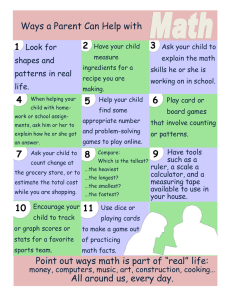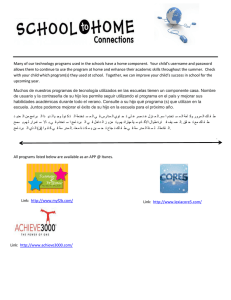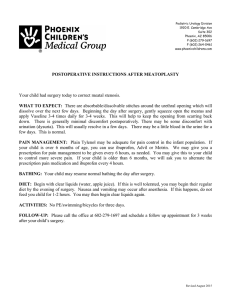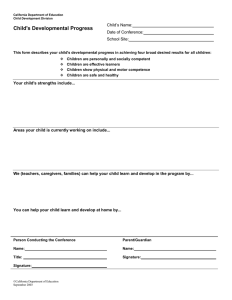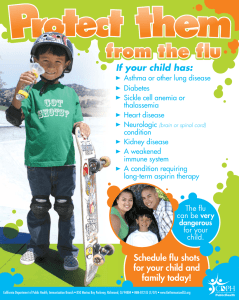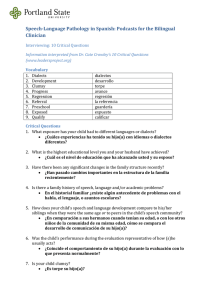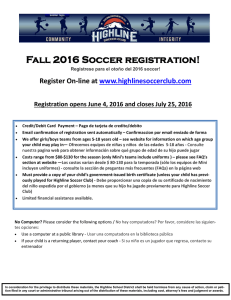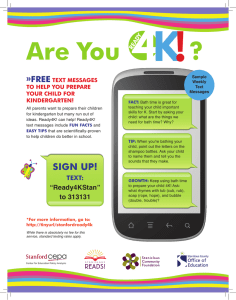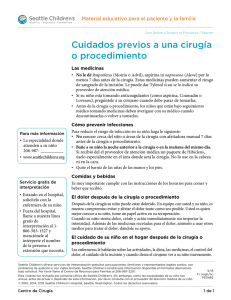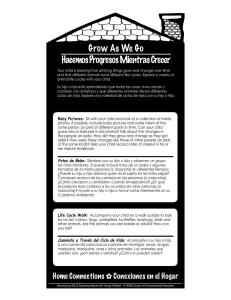PE1141S Care After Knee or Lower Leg Surgery
Anuncio
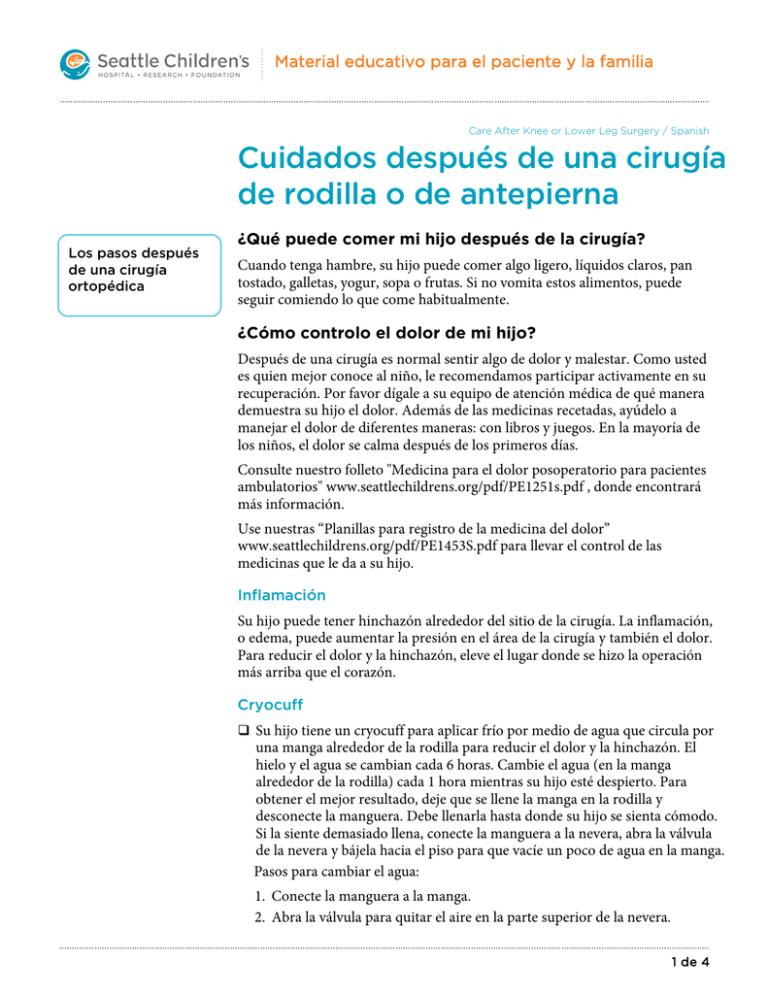
Material educativo para el paciente y la familia Care After Knee or Lower Leg Surgery / Spanish Cuidados después de una cirugía de rodilla o de antepierna Los pasos después de una cirugía ortopédica ¿Qué puede comer mi hijo después de la cirugía? Cuando tenga hambre, su hijo puede comer algo ligero, líquidos claros, pan tostado, galletas, yogur, sopa o frutas. Si no vomita estos alimentos, puede seguir comiendo lo que come habitualmente. ¿Cómo controlo el dolor de mi hijo? Después de una cirugía es normal sentir algo de dolor y malestar. Como usted es quien mejor conoce al niño, le recomendamos participar activamente en su recuperación. Por favor dígale a su equipo de atención médica de qué manera demuestra su hijo el dolor. Además de las medicinas recetadas, ayúdelo a manejar el dolor de diferentes maneras: con libros y juegos. En la mayoría de los niños, el dolor se calma después de los primeros días. Consulte nuestro folleto "Medicina para el dolor posoperatorio para pacientes ambulatorios" www.seattlechildrens.org/pdf/PE1251s.pdf , donde encontrará más información. Use nuestras “Planillas para registro de la medicina del dolor” www.seattlechildrens.org/pdf/PE1453S.pdf para llevar el control de las medicinas que le da a su hijo. Inflamación Su hijo puede tener hinchazón alrededor del sitio de la cirugía. La inflamación, o edema, puede aumentar la presión en el área de la cirugía y también el dolor. Para reducir el dolor y la hinchazón, eleve el lugar donde se hizo la operación más arriba que el corazón. Cryocuff Su hijo tiene un cryocuff para aplicar frío por medio de agua que circula por una manga alrededor de la rodilla para reducir el dolor y la hinchazón. El hielo y el agua se cambian cada 6 horas. Cambie el agua (en la manga alrededor de la rodilla) cada 1 hora mientras su hijo esté despierto. Para obtener el mejor resultado, deje que se llene la manga en la rodilla y desconecte la manguera. Debe llenarla hasta donde su hijo se sienta cómodo. Si la siente demasiado llena, conecte la manguera a la nevera, abra la válvula de la nevera y bájela hacia el piso para que vacíe un poco de agua en la manga. Pasos para cambiar el agua: 1. Conecte la manguera a la manga. 2. Abra la válvula para quitar el aire en la parte superior de la nevera. 1 de 4 Los cuidados después de una cirugía de rodilla o antepierna 3. Levante el recipiente 15 a 18 pulgadas sobre la rodilla para reemplazar el agua más caliente de la manga por el agua fría del recipiente. 4. Mantenga la nevera elevada 15 pulgadas sobre la rodilla por 20 minutos. Después, puede cerrar todas las válvulas en la parte superior de la nevera. 5. Desconecte la manguera. En este sitio encontrará un vídeo hecho por DME Direct, donde se explica cómo usar el Cryo Cuff: www.youtube.com/watch?v=H3iDzAcrWJ ¿Cuándo se puede mojar mi hijo? Mantenga el vendaje (apósito) completamente seco por ___ días. Después de ___ días, se puede bañar con regadera. Un rápido baño en la tina es también aceptable pero no debe pasar mucho tiempo en la tina ni sumergir la herida bajo agua. Su hijo debe evitar meterse en el agua por un mínimo de 2 semanas después de la cirugía. Su hijo tuvo una cirugía en la rodilla y tendrá la pierna envuelta en vendas desde la cadera al tobillo. Después de bañarse vende de nuevo la pierna, desde la mitad del muslo hasta la mitad de la antepierna, y póngale la manga Cryocuff sobre el vendaje. Si le indicaron usar una férula para la rodilla, colóquela también sobre el Cryocuff. ¿Qué cuidados necesita el sitio de la cirugía? El grupo de atención médica marcará abajo los pasos que debe seguir. Steri-strips sobre la herida (incisión): • Steri-Strips son cintas adhesivas finas que cubren las puntadas internas absorbibles. • No use cremas sobre las cintas. • Deje las cintas hasta que se desprendan solas. Se cerró la herida (incisión) con pegamento quirúrgico (Dermabond). • Mantenga la piel limpia con agua y jabón. • No use cremas en el área. • El pegamento se desprenderá solo en aproximadamente una semana. Su hijo tiene una rodillera. Se la puede quitar para bañarse y para hacer los ejercicios de la terapia. El resto del tiempo tiene que llevarla puesta en la pierna. No le haga ajustes a la rodillera. Su hijo tiene un vendaje (apósito), férula o yeso sobre la incisión; No se lo quite hasta que lo vean en la cita. Manténgalo seco por ___días. Después, se lo puede quitar. Pero si hay steri-strips déjelas en su lugar. Siga las indicaciones del folleto que le dieron sobre "Cuidados del yeso". 2 de 4 Los cuidados después de una cirugía de rodilla o antepierna ¿Cuánta actividad física puede hacer mi hijo? Durante las primeras 4 a 6 horas en casa después de la cirugía, su hijo sólo debe hacer actividades tranquilas bajo la supervisión de un adulto. Después puede hacer más actividad. Lo mejor es que su hijo haga solo lo que tolere, él mismo limitará su actividad si no se siente bien. El nivel de actividad de su hijo dependerá del tipo de cirugía. Siga las instrucciones marcadas a continuación: Su hijo puede iniciar los ejercicios que le indicó el fisioterapeuta (levantar la pierna y doblar suavemente la rodilla) empezando el día de la cirugía. Si los ejercicios le causan mucha molestia, puede intentar al día siguiente. Algunas veces el movimiento ayuda a disminuir el dolor. Si su hijo tiene una rodillera, se la puede quitar para hacer los ejercicios. Vuelva a colocarla al terminar los ejercicios. Su hijo puede apoyar la pierna hasta donde pueda. Si es necesario, use muletas. Su hijo puede apoyar solo el ___ % del peso de su cuerpo en la pierna. Utilice las muletas. Su hijo no puede poner nada de peso en la pierna. Utilice las muletas. Una vez que la sensación y el movimiento regresan a la pierna y al pie, solamente puede quitarle el vendaje y la goma espuma del pie. Si su hijo ya maneja, no debe conducir durante las primeras 24 horas después de la cirugía o mientras esté tomando medicamentos recetados para el dolor. Puede manejar si solo está tomando medicamentos para dolores leves, como Tylenol o Advil. No conducir mientras use la rodillera. ¿Cuándo puede mi hijo regresar a la escuela o guardería? La mayoría de los niños no van a la escuela el día de la cirugía ni al día siguiente. Esto les da tiempo a recuperarse del procedimiento y de la anestesia. Su hijo puede volver a la escuela cuando se sienta bien y ya no necesite tomar medicina fuerte para el dolor. Algunos niños no pueden hacer educación física, deportes ni participar en juegos fuertes por un tiempo. Por favor consulte con el cirujano si su hijo puede participar en estas actividades o tiene que esperar. 3 de 4 Los cuidados después de una cirugía de rodilla o antepierna Para más información • Durante horario de oficina, llame a Ortopedia al 206-987-2109. • Operadora de Seattle Children’s 206-987-2000, de noche y fin de semana • Hable con el proveedor de atención médica de su hijo • www.seattlechildrens.org ¿Cuándo debo llamar al equipo de atención médica de mi hijo? Por favor, llame si su hijo tiene cualquiera de estos signos de alerta: • Fiebre de 101.5°F o más. • Enrojecimiento en la piel que se extiende alrededor de la herida. • Si sangra, supura sangre o pus por debajo del vendaje o de la herida. • Dolor fuerte o constante o que empeora en el sitio de la cirugía, aun cuando toma la medicina para el dolor. • Vomita más de una vez. Durante el horario de oficina llame a Ortopedia al 206-987-2109. De noches y fin de semana, llame al operador de Seattle Children's al 206-987-2000 y pida hablar con médico ortopédico de guardia. ¿Cuándo verán a mi hijo de nuevo? Su hijo tiene cita: Servicio gratuito de interpretación • En el hospital, solicítelo a la enfermera. • Fuera del hospital, llame a la línea gratuita de interpretación: 1-866-583-1527. Menciónele al intérprete el nombre de la persona o extensión que necesita. Radiología: _____________________________________________________ Ortopedia: _____________________________________________________ Fisioterapia: ____________________________________________________ Favor llamar a Ortopedia para confirmar la hora de la cita. Veremos a su hijo en el siguiente lugar: Seattle Children's 4800 Sand Point Way NE, Seattle, WA 98105, piso 6, entrada Océano. Bellevue Clinic 1500 116 Ave. NE, Bellevue, WA 98004. Mill Creek Clinic 12800 19th Ave. SE, Suite 150 (aka Bothell–Everett Highway) Everett, WA 98208. Información relacionada: Medicina para el dolor posoperatorio para pacientes ambulatorios www.seattlechildrens.org/pdf/PE1251S.pdf Planilla para registro de la medicina del dolor www.seattlechildrens.org/pdf/PE1453S.pdf Seattle Children's ofrece servicio gratuito de interpretación para pacientes, familiares y representantes legales sordos, con problemas de audición o con inglés limitado. Seattle Children's tendrá disponible esta información en formatos alternativos bajo solicitud. Llame al Centro de Recursos Familiares al 206-987-2201. Este volante fue revisado por el personal clínico de Seattle Children's. Sin embargo, como las necesidades de su hijo son únicas, antes de actuar o depender de esta información, por favor consulte con el proveedor de atención médica de su hijo. © 2010, 2011, 2013, 2015, 2016 Seattle Children’s, Seattle, Washington. Todos los derechos reservados. Ortopedia 7/16 Tr (lv/jw) PE1941S 4 de 4 Patient and Family Education Care After Knee or Lower Leg Surgery Steps to follow after orthopedics surgery What can my child eat after surgery? It is OK for your child to have something light to eat when they are hungry. Examples of foods that are OK are clear liquids, toast, crackers, yogurt, soup and fruit. If food stays down, then your child may eat what they usually eat. How do I help manage my child’s pain? Pain and discomfort are normal after surgery. You know your child best. We encourage you to take an active part in your child’s recovery. Please talk with your child’s care team about how your child shows that they are hurting. In addition to medicine prescribed for pain, encourage coping tools, like books and games, to treat pain and provide support. Pain gets better for most children after the first few days. Refer to our handout, “Pain Medicine after Outpatient Surgery” www.seattlechildrens.org/pdf/PE1251.pdf for more information. Use our “Pain Medicine Log” www.seattlechildrens.org/pdf/PE1453.pdf to keep track of the pain medicine you have given your child. Swelling Your child may have swelling around the surgery site. Swelling causes increased pressure in the area of surgery and increases pain. To reduce pain and swelling, elevate the surgical site above the heart. Cryocuff Your child has a cryocuff. The cooling cuff circulates cold water around the knee and helps reduce pain and swelling. The ice in the canister will need to be refilled with ice and water about every 6 hours. Exchange the water in the cuff every hour when your child is awake. For best results, leave cuff filled and disconnect hose. The cuff should be full but also comfortable. If your child feels like the cuff is too full, you may connect the hose to the cuff, open the valve on the cooler, and lower the cooler to let some of the water drain back into the cooler. Steps to exchange the water in cooling cuff: 1. Connect hose to cuff. 2. Open air valve on top of canister. 3. Raise canister 15 to 18 inches above the knee, allowing water in the canister to exchange with warmer water in the cuff. 1 of 4 Care After Knee or Lower Leg Surgery 4. Keep the canister raised 15 inches above the knee for 20 minutes, then close all of the valves at the top of the canister. 5. Disconnect the hose. Here is a video made by DME Direct to help describe how to use the Cryo Cuff: www.youtube.com/watch?v=H3iDzAcrWJ8 When can my child get wet? Keep the bandages (dressing) completely dry for ____ days. After ____ days, a shower is OK. A quick bath in the tub is also OK, but your child should avoid a long soak in the tub, and should avoid putting the surgical site under the water. Your child should avoid swimming for at least 2 weeks after surgery. Your child had knee surgery and will have their leg wrapped in ACE bandages from their hip to ankle. After showering, re-wrap the leg from mid-calf to mid-thigh and put the Cryocuff on top of the ACE bandages. If you were fit with a knee brace, put the brace back on top of the Cryo Cuff. How should I take care of my child’s surgery site? Your child’s healthcare team will check the box next to the steps you should follow. Steri-Strips over the cut (incision) • Steri-Strips are thin pieces of tape that are on top of dissolvable stitches under the skin. • Do not put ointment over the Steri-Strips. • Leave Steri-Strips on until they fall off on their own. Cut (incision) is closed with skin glue (Dermabond) • Keep the skin clean with soap and water. • Do not put ointment on the area. • The glue will flake off on its own after about a week. Your child has a knee brace. It may be removed for therapy exercises and bathing, but otherwise needs to be on the leg. Do not adjust the settings. Your child has a bandage (dressing), splint, or cast over their incision; Leave it alone until you follow up in the clinic. Keep dry for ___days. After that, it is OK for you to remove, but leave any Steri-strips in place. Follow “Cast Care” guidelines that were given to you. How active can my child be? For the first 4 to 6 hours at home after surgery, your child should do only quiet activities, with an adult watching. After this period, it is OK for your child to be more active. It is best to listen to your child about what feels OK. Your child will tend to limit their own activity if they feel uncomfortable. 2 of 4 Care After Knee or Lower Leg Surgery Your child’s activity level will depend on the type of surgery they had. Follow the instructions checked below: Your child may start exercises given to you by the physical therapist. (leg raises and gently bending the knee) starting the day of surgery. If the exercises are too uncomfortable, try again the next day. Sometimes movement helps decrease pain. If your child has a knee brace, it is OK to remove the brace for these exercises. Put the brace back on after doing the exercises. Your child may put as much weight on the leg as they can. Use crutches if needed. Your child may put only ____% of their body weight on the leg. Use crutches for help. Your child may not put any weight on the leg. Use crutches. Once feeling and movement returns to the leg and foot, you may remove ACE wrap and foam from foot only. If your child drives a car, they should not drive for the first 24 hours after surgery or while they are taking medicines prescribed for pain. It is OK to drive if they are only taking mild pain medicines, like Tylenol or Advil. No driving while wearing knee brace. When can my child go back to school or daycare? Most children will stay home the day of surgery and the day after surgery. This gives them time to recover from the procedure and from anesthesia. It is OK for your child to return to school when they are comfortable and when they no longer need strong pain medication, like oxycodone. Some children will need to be excused from PE, sports and rough play. Please check with your surgeon to see if these activities are OK for your child or if they need to wait. When should I call my child’s healthcare team? Please call us if your child has any of these warning signs: • Fever of 101.5° F or higher • Redness on the skin spreading from the incision area • New bleeding or oozing blood or pus under the bandage dressing or at the incision • Very bad or constant pain, or pain that gets worse at the surgery site, even after giving pain medicine • Vomits more than once Call the Orthopedics Clinic at 206-987-2109 during weekday business hours. On evenings and weekends, call the operator at Seattle Children’s at 206-987-2000. Ask the operator to page the orthopedic resident on call. 3 of 4 Care After Knee or Lower Leg Surgery To Learn More When will my child need to be seen again? • Orthopedics Clinic 206-987-2109 weekdays during business hours • Seattle Children’s Operator 206-987-2000 evenings and weekends • Ask your child’s healthcare provider • www.seattlechildrens.org Your child is scheduled for a follow-up appointments on: Radiology: _____________________________________________________ Ortho: ________________________________________________________ Physical Therapy: _______________________________________________ Please call the Orthopedics Clinic to confirm your appointment time. Your child will be seen at the following location: Seattle Children’s Main Campus 4800 Sand Point Way NE, Seattle, WA 98105 Level 6, Ocean zone entrance Bellevue Clinic 1500 116 Ave. NE, Bellevue, WA 98004 Mill Creek Clinic Free Interpreter Services • In the hospital, ask your child’s nurse. • From outside the hospital, call the toll-free Family Interpreting Line 1-866-583-1527. Tell the interpreter the name or extension you need. 12800 19th Ave. SE, Suite 150 (aka Bothell–Everett Highway) Everett, WA 98208 Partner handouts: Pain Medicine after Outpatient Surgery www.seattlechildrens.org/pdf/PE1251.pdf Pain Medicine Log www.seattlechildrens.org/pdf/PE1453.pdf Seattle Children’s offers interpreter services for Deaf, hard of hearing or non-English speaking patients, family members and legal representatives free of charge. Seattle Children’s will make this information available in alternate formats upon request. Call the Family Resource Center at 206-987-2201. This handout has been reviewed by clinical staff at Seattle Children’s. However, your child’s needs are unique. Before you act or rely upon this information, please talk with your child’s healthcare provider. © 2010, 2011, 2013, 2015, 2016 Seattle Children’s, Seattle, Washington. All rights reserved. Orthopedics 7/16 PE1141 4 of 4
